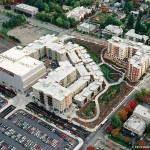 If a sprawling mall parking lot is one of the symbols of suburban America, this particular lot is a perfect example of how the suburbs are changing: Six acres of pavement have just been turned into the beginnings of a walkable community, complete with a new park that’s helping restore a creek for local salmon.
If a sprawling mall parking lot is one of the symbols of suburban America, this particular lot is a perfect example of how the suburbs are changing: Six acres of pavement have just been turned into the beginnings of a walkable community, complete with a new park that’s helping restore a creek for local salmon.
The shopping center next door–Northgate Mall–was one of the first suburban malls in the country, built in 1950. The surrounding neighborhood used to be the kind of place where any errand required a car. But thanks in part to Seattle’s aggressive plan for growth management, and the fact that no one really wants to live in the burbs anymore, things have changed.
“Throughout urban America, obviously there’s a huge movement back to cities for very good reasons. It’s a demographic shift, it’s a lifestyle shift, a cost shift, a commute time shift,” says Bert Gregory, CEO of Mithun, the architectural firm that turned the parking lot into a new neighborhood.
“In the Seattle-Puget Sound area, we’ll have about 1.7 million more people coming into our community by 2040,” Gregory adds. “That’s essentially almost three Seattles that have to be accommodated in our metropolitan area.” Since Washington has laws on the books limiting sprawl–protecting farmland, forests, and other open spaces around cities from development–places like Northgate are the perfect place to squeeze in the coming hordes.
The development, called Thornton Place, includes 387 LEED-certified apartments, senior housing, a medical center, and more retail space. In part because it was deliberately located near public transportation (including, soon, a new light rail station a block away), along with several other sustainable features, it qualified as the city’s first LEED Silver neighborhood.
Before the area was originally developed in the 1950s, it was the headwaters of Thornton Creek, a stream critical for wildlife, especially spawning salmon. But a highway built nearby cut off the headwaters, and the stream was covered with a culvert. The new project aims to improve things for the salmon, and turned a big chunk of the parking lot into a “bioswale,” a park that filters out pollution before it can reach the creek.
No one really misses the giant parking lot, which Gregory says was empty much of the time anyway. Public transportation use has jumped from 18% to 80% among neighbors. And already, over 20% of residents don’t own a car at all.
Speak Your Mind
You must be logged in to post a comment.